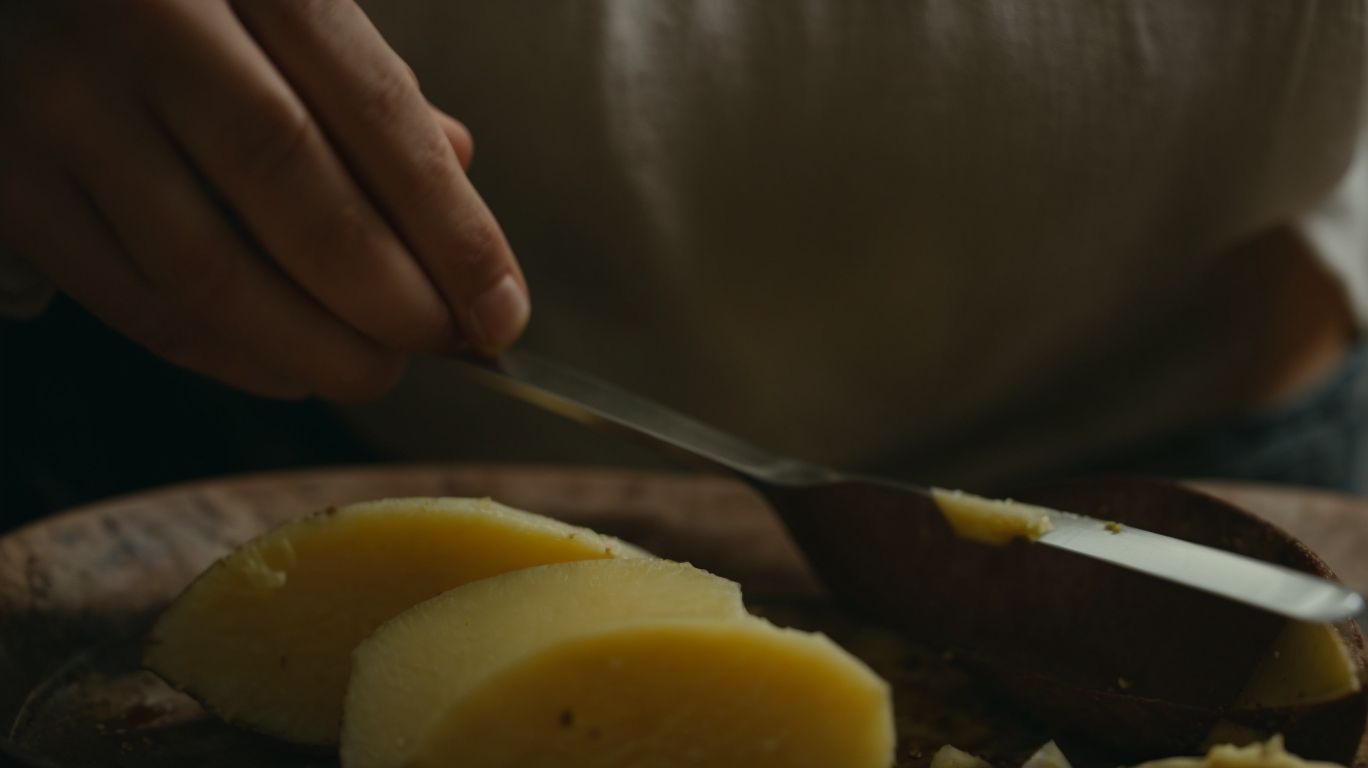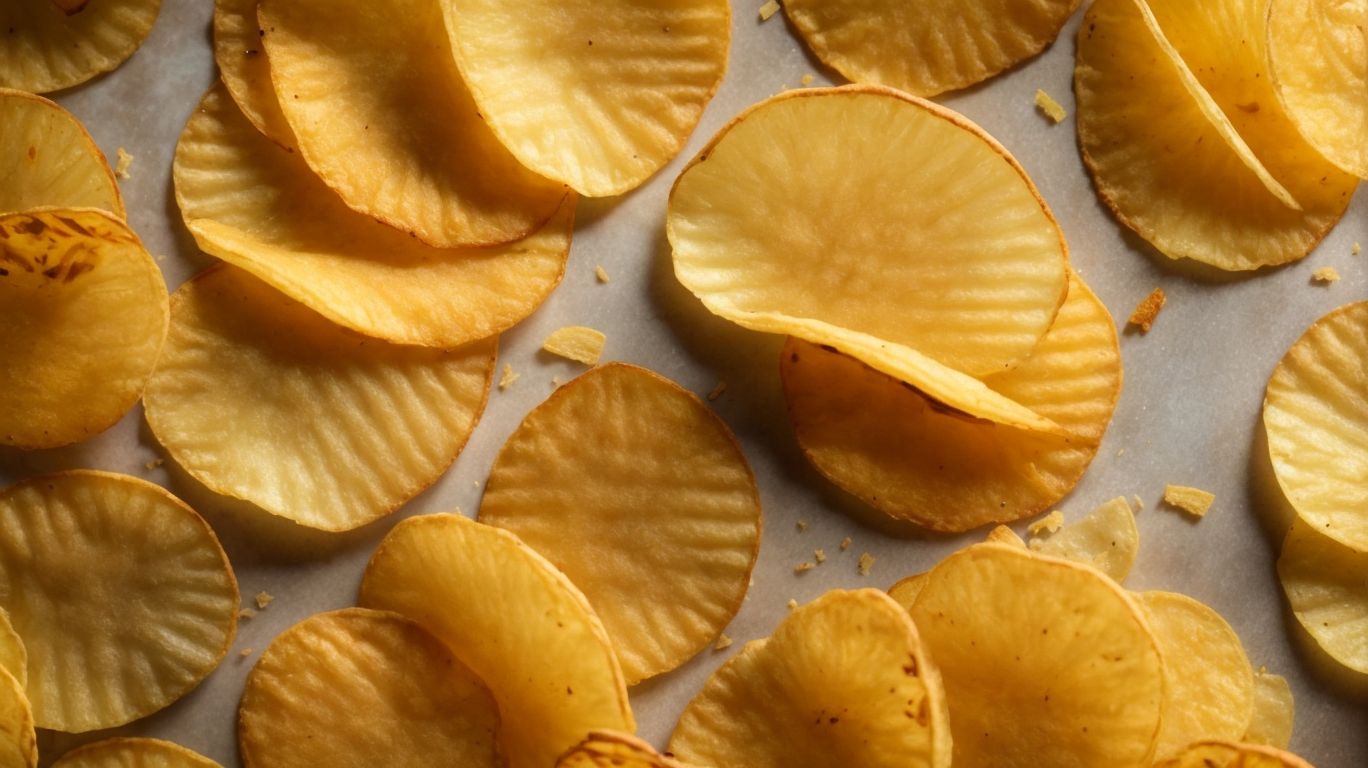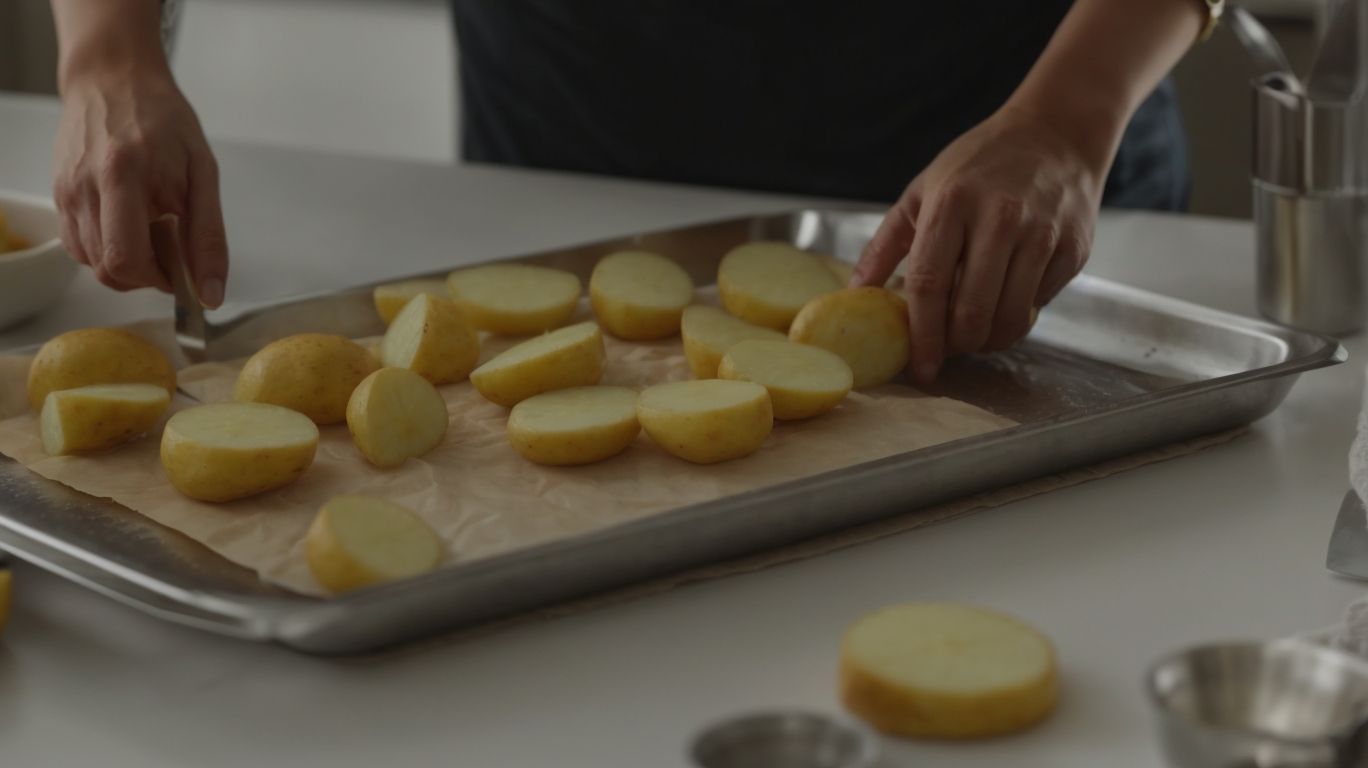How to Bake Potatoes Into Chips?
Do you ever wonder what sets baked potato chips apart from their fried counterparts?
In this article, we will explore the process of making delicious and crispy baked potato chips right in your own kitchen.
From the ingredients and tools needed to the steps for preparing and seasoning the potatoes, we will guide you through the entire process.
Find tips on achieving the perfect crispy texture and avoiding burnt chips. Elevate your snack game with our foolproof recipe!
Key Takeaways:
What Makes Baked Potato Chips Different from Fried Ones?
The key distinction between baked potato chips and fried ones lies in the cooking method and resulting texture and taste.
Baked potato chips are often considered a healthier alternative to their fried counterparts due to the reduced fat content. When baking potato chips, the potatoes are sliced thinly, seasoned, and then baked in the oven until they achieve a crispy texture. This cooking method helps retain more of the potato’s nutrients compared to deep-frying, where the chips absorb a significant amount of oil.
In terms of flavor, baked potato chips can have a slightly different taste profile than fried chips. They tend to have a nuttier and earthier flavor due to the baking process, which can appeal to those looking for a more wholesome snack option.
What You Need to Bake Potato Chips
To bake delicious potato chips at home, you’ll need a few key ingredients and tools to ensure a crispy and flavorful outcome.
Ingredients for Baked Potato Chips
The ingredients for baked potato chips include russet potatoes, olive oil, and a variety of seasonings to enhance the flavor profile.
Russet potatoes, also known as baking potatoes, are ideal for making potato chips due to their low moisture and high starch content, which helps achieve that desired crispy texture.
Olive oil is the preferred choice for baking as it adds a hint of richness and helps with browning. In terms of seasonings, options like sea salt, garlic powder, paprika, or even a mix of rosemary and thyme can elevate the taste profile of the chips, offering a range of savory and aromatic notes. Experimenting with different herbs and spices allows for customization based on personal preferences, creating a unique snacking experience each time.
Tools for Baked Potato Chips
When preparing baked potato chips, essential tools such as a mandolin slicer, baking sheet, and parchment paper are crucial for achieving uniform slices and even baking.
Using a sharp paring knife or a chef’s knife as an alternative to the mandolin slicer can work well for those who prefer hand-cut slices. The mandolin slicer is highly recommended for consistency in thickness. Ensure to season the potato slices with the right blend of olive oil, salt, and spices before laying them out in a single layer on the baking sheet lined with parchment paper. This careful preparation ensures that each chip crisps evenly during baking, resulting in a delightful snacking experience.
How to Prepare the Potatoes for Baking?
Properly preparing the potatoes before baking is crucial for achieving crispy and delicious homemade potato chips.
Washing and Drying the Potatoes
Before turning them into delectable chips, ensure to thoroughly wash and dry the potatoes to remove any dirt or residue, allowing for uniform slicing and consistent baking.
“
Washing and drying potatoes before preparing them is a crucial step in ensuring the quality and taste of your final dish. By properly cleaning the potatoes, you not only remove any surface dirt but also get rid of potential bacteria that can linger on the skin. Drying the potatoes thoroughly before slicing them helps to achieve the desired crispiness in your chips, as excess moisture can hinder the baking process.
Proper cleaning and drying techniques are essential to guarantee a satisfying crunch and flavor in every bite of your homemade potato chips.
Slicing the Potatoes into Chips
The key to perfect potato chips lies in thinly slicing the potatoes using a mandolin or sharp knife to achieve uniform thickness for even baking.
When slicing the potatoes, consistency is paramount to ensure that each chip cooks at the same rate, resulting in a uniformly crispy batch. A mandolin, with adjustable settings, allows for precision in achieving the desired thickness, typically around 1/16 inch. It is essential to use a sharp blade to prevent bruising or tearing the potatoes, which can affect the final texture of the chips. Some chefs prefer using a knife for a hands-on approach, ensuring careful control over each slice.
How to Season the Potato Chips?
Seasoning your potato chips with the right blend of seasonings is crucial to enhancing their taste and creating a flavor explosion with each bite.
Choosing the Right Seasonings
Selecting the right seasonings for your potato chips opens up a world of flavor possibilities, from classic salt and vinegar to adventurous chili and lime combinations.
In terms of potato chips, the seasoning you choose can truly elevate the snacking experience. Spices not only add depth and complexity to the flavor but also bring a unique twist to the familiar crunch. Experimenting with different combinations like smoky paprika and garlic or tangy dill pickle can turn a simple snack into a gourmet treat. Understanding how different spices interact with each other and with the potato base can help you create mouthwatering variations tailored to your taste preferences.
Coating the Potato Chips with Seasonings
Coating the potato chips with a flavorful mix of seasonings ensures that each bite is a delightful explosion of crispy texture and delicious taste.
To achieve an evenly coated batch of potato chips, start by choosing your desired seasoning blend. Make sure the potato chips are cool and dry before sprinkling the seasonings. One effective method is to place the chips in a large bowl and sprinkle the seasonings gradually, tossing gently to ensure each chip is covered. For a more efficient coating, consider using a shaker or a sealable bag to evenly distribute the seasonings. Popular flavor combinations such as salt and vinegar, barbecue, or spicy jalapeno can elevate the taste profile of your chips, providing a variety of options for different preferences.
How to Bake the Potato Chips?

Credits: Poormet.Com – Lawrence Gonzalez
Baking the perfect batch of potato chips requires precision in preheating the oven and mastering the baking process to achieve irresistibly crispy chips.
Preheating the Oven
Ensuring that your oven is properly preheated is essential for baking potato chips at the right temperature to achieve the desired level of crispiness.
When preheating your oven for potato chip perfection, it’s crucial to set it to a specific temperature. Preheat your oven to 400°F for that ideal balance of crunch and tenderness. This temperature allows the potatoes to crisp up without burning, giving you that satisfying texture with a golden hue.
For optimal baking conditions, spread the thinly sliced potato rounds evenly on a baking sheet lined with parchment paper to ensure even cooking. Flipping the chips halfway through baking can help to achieve an all-around crispy chip. Remember, the preheating process is the foundation for achieving that perfect potato chip texture.
Baking the Potato Chips
The baking process transforms sliced potatoes into golden, crispy chips when executed with precision and attention to detail in following the baking instructions.
To achieve the perfect crispy potato chips, start by preheating your oven to 400°F. While the oven is heating up, thinly slice your potatoes using a sharp knife or a mandoline slicer for consistent thickness.
Spread the potato slices in a single layer on a parchment-lined baking sheet, ensuring they do not overlap to promote even cooking.
Place the baking sheet in the preheated oven and bake for around 20-25 minutes, flipping the chips halfway through the cooking time for uniform crispiness. Keep a close eye on the chips towards the end of the baking process to prevent them from burning.
How to Store and Serve the Baked Potato Chips?
Proper storage and serving of baked potato chips are essential to maintain their crispness and flavor for enjoyable snacking experiences.
Proper Storage for Baked Potato Chips
Storing baked potato chips in an airtight container at room temperature helps preserve their crispiness and prevents moisture absorption, ensuring freshness for enjoying leftovers.
In terms of maintaining the quality of baked potato chips, choosing the right storage solution is crucial. By storing them in an airtight container, you shield the chips from exposure to air, which can lead to sogginess. The room temperature environment is ideal for keeping the chips crispy without the risk of them becoming stale.
To further extend the shelf life of your baked potato chips, consider adding a silica gel packet to the container to absorb any excess moisture. This simple trick can help prevent the chips from becoming soft and losing their crunchiness over time. Remember to avoid storing the chips in the refrigerator, as the cold temperature can cause them to lose their texture and flavor.
Serving Suggestions for Baked Potato Chips
Pairing baked potato chips with complementary dips or incorporating them as a side dish elevates the snacking experience and offers versatile serving options for different occasions.
One creative way to serve baked potato chips is to create a DIY chips bar with various toppings like shredded cheese, bacon bits, green onions, and sour cream, allowing guests to customize their own loaded chips. Alternatively, for a more elegant presentation, layer the chips onto a platter with rosemary-infused olive oil drizzle and sprinkle with sea salt and freshly ground black pepper for a gourmet touch. The crispy texture of the chips also makes them a delightful addition to sandwiches, burgers, or wraps, providing a satisfying crunch to every bite.
Tips and Tricks for Perfect Baked Potato Chips

Credits: Poormet.Com – Charles Moore
Mastering the art of crafting perfect baked potato chips involves employing smart tips and tricks to achieve optimal crispiness and avoid common pitfalls like burnt chips.
How to Get Crispy Chips?
To achieve irresistibly crispy chips, ensure even slicing, proper seasoning distribution, and precise baking techniques that promote optimal crispness without compromising on flavor.
One key technique to enhance the texture of potato chips is to soak the sliced potatoes in cold water for 30 minutes prior to cooking to remove excess starch, which can hinder crispiness. This step also helps in achieving that sought-after crunch when the chips are baked.
Selecting the right type of potato, such as russet or Yukon Gold, can make a significant difference in the final texture. These varieties are known for their high starch content, which contributes to a satisfying crunch.
Ensuring the chips are spread out evenly on the baking sheet, without overcrowding, allows for proper air circulation and even baking, resulting in uniformly crispy chips.
How to Avoid Burnt Chips?
Preventing burnt chips involves monitoring baking times closely, adjusting oven settings as needed, and being vigilant during the final stages of baking to ensure perfectly golden results.
One essential tip is to make sure your oven temperature is accurate by using an oven thermometer. Sometimes, ovens can be off by several degrees, leading to uneven cooking.
Another helpful method is to spread the potato slices evenly on the baking sheet, ensuring they are not overlapping, to promote consistent baking.
When monitoring the baking progress, keep an eye out for the edges becoming too dark too quickly, a sign that the chips may be on the verge of burning.
If you find your chips slightly overcooked, try salvaging them by placing them in a resealable bag with a piece of bread or a slice of apple overnight to help restore some moisture and crispness.
Frequently Asked Questions
1. What is the best kind of potato to use for making chips?
Russet potatoes are the best choice for making chips as they have a high starch content, which results in a crispier chip.
2. How do I prevent my chips from becoming soggy?
After slicing the potatoes, soak them in cold water for at least 30 minutes. This will remove excess starch and prevent your chips from turning soggy.
3. Can I use sweet potatoes to make chips?
Yes, you can use sweet potatoes to make chips, but they will have a slightly different texture and flavor compared to regular potato chips.
4. Do I need to peel the potatoes before slicing them?
It is not necessary to peel the potatoes if you prefer the skin on your chips. However, make sure to wash and scrub the potatoes thoroughly before slicing.
5. How thick should I slice the potatoes for chips?
For the perfect chip, slice the potatoes into thin, even slices, about 1/8 inch thick.
6. Can I bake potato chips without oil?
While oil is commonly used to make potato chips, you can bake them without oil for a healthier option. Simply brush the sliced potatoes with a small amount of oil or cooking spray before baking.

